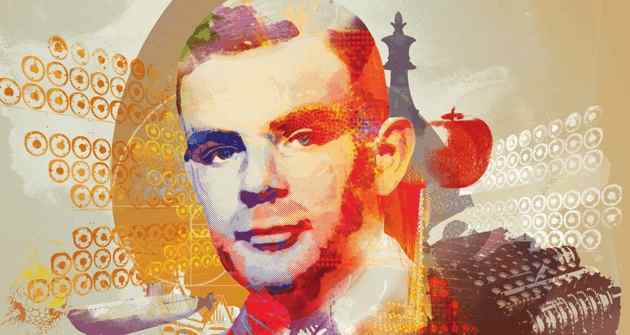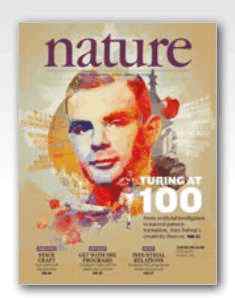| Turing Year: The Legacy Explored |
| Written by Sue Gee | |||
| Monday, 27 February 2012 | |||
|
Even though the 100th anniversary of Turing's birth isn't until June, Nature has already published its Turing Special. The first presentation of this year's IET/BCS Turing Lecture has also already taken place and can be viewed online. The headline of the editorial Turing at 100 in the special issue of Nature states: This year marks the centenary of the birth of Alan Turing. He deserves your attention. Having drawn attention to other articles in the issue the editorial concludes: What could 2012, the Alan Turing year, be named? Nature suggests 'The Year of Intelligence'. Of the finest types of intelligence — human, artificial and military — Turing is perhaps the only person to have made a world-changing contribution to all three. Use this special issue, and the rest of 2012, to discover and make up your own mind about this extraordinary man.
The editor for this special issue, Tanguy Chouard provides an overview of the articles in Turing at 100:Legacy of a universal mind starting with a short item, The man behind the machine from Andrew Hodges the Oxford University Mathematician who wrote the 1992 biography Alan Turing: the Enigma. The selection of articles in the issue demonstrates just how versatile a polymath Turing was. Most of us think first of his contributions to code-breaking and the development of the Manchester Computers but that is to overlook other his interests. I Programmer has already reported on some recent work following up Turing's ideas in morphogenesis and this is the topic of an article on Pattern Formation by John Reinitz. In another article, Life's code script, molecular biologist Sydney Brenner considers how Turing machines and cells have much in common.
It is widely accepted that Turing's most important published paper is "On Computable Numbers, with an Application to the Entscheidungsproblem" and that it inaugurated the field of computability. In an invited contribution to the forthcoming book Alan Turing: His Work and Impact, mathematician Robert Soare, the founding chairman of the University of Chicago's computer science department, proposes that Turing's achievement was artistic as well as scientific. In his chapter "Turing and Michelangelo: The Art of Classical Computability" Soare compares the concepts in the seminal 1936 paper to Michelangelo's statue, David: This year's IET/BCS Turing Lecture also looked at twin aspects of Turing legacy. Neuroscientist Ray Dolan's talk From cryptanalysis to cognitive neuroscience - a hidden legacy of Alan Turing was delivered in London last week and explored how Turing's strongly Bayesian problem solving approaches have advanced developments in understanding the workings of the brain and the human mind. There is still two chances to hear it live - in Manchester on February 28 and in Edinburgh on February 29 (details from the BCS website). But if you can't attend in person the complete London event is now available to watch on IET TV. More InformationMathematician sees artistic side to father of computer
Related ArticlesWidespread Celebrations But No Pardon For Turing Commemorative Stamp for Alan Turing Alan Turing Year - New Documentary and Lots of Events Alan Turing - born on this day 99 years ago Leonardo di Caprio to play Alan Turing?
Comments
or email your comment to: comments@i-programmer.info |
|||
| Last Updated ( Friday, 07 June 2024 ) |




